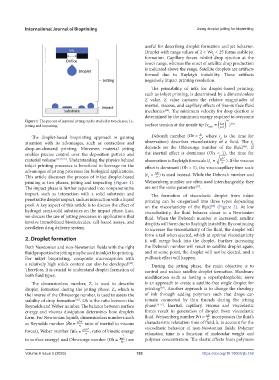Page 201 - IJB-9-5
P. 201
International Journal of Bioprinting Using droplet jetting for bioprinting
useful for describing droplet formation and jet behavior.
Droplet with range values of 2 < We < 25 forms stable jet
j
formation. Capillary forces inhibit drop ejection at the
lower range, whereas the onset of satellite drop production
is indicated above the range. Satellite droplets are artifacts
formed due to Rayleigh instability. These artifacts
negatively impact printing resolution.
The printability of inks for droplet-based printing,
such as inkjet printing, is determined by a dimensionless
Z value. Z value captures the relative magnitudes of
inertial, viscous, and capillary effects of free-surface fluid
mechanics . The minimum velocity for drop ejection is
[44]
determined by the minimum energy required to overcome
Figure 1. The process of material jetting can be studied at two phases, i.e., 4.σ 12/
[45]
=
jetting and impacting. surface tension at the nozzle tip (v min ( ) ) .
d . ρ
λ
The droplet-based bioprinting approach is gaining Deborah number (De = , where t is the time for
p
t p
attention with its advantages, such as contactless and observation) describes viscoelasticity of a fluid. The t
p
[46]
drop-on-demand printing. Moreover, material jetting depends on the Ohnesorge number of the fluid . If
enables precise control over the deposition pattern and the inertial effect is dominant (Oh < 1), the time for
material volume [24,25,41] . Understanding the physics behind observation is Rayleigh timescale (t = ρ D σ 3 ). If the viscous
c
inkjet printing processes is beneficial to leverage on the effect is dominant (Oh > 1), the visco-capillary time scale
advantages of jetting processes for biological applications. η D
This article discusses the process of inkjet droplet-based (t = σ ) is used instead. While the Deborah number and
v
printing at two phases, jetting and impacting (Figure 1). Weissenberg number are often used interchangeably, they
[47]
The impact phase is further separated into nonpenetrative are not the same parameter .
impact, such as interaction with a solid substrate; and The formation of viscoelastic droplet from inkjet
penetrative droplet impact, such as interaction with a liquid printing can be categorized into three types depending
pool. A key aspect of this article is to discuss the effect of on the viscoelasticity of the fluid (Figure 2). At low
[48]
hydrogel semi-solid substrates on the impact phase. Last, viscoelasticity, the fluid behaves closer to a Newtonian
we discuss the use of jetting processes in applications that fluid. When the Deborah number is increased, satellite
involve immobilized biomolecules, cell-based assays, and droplets will form due to Rayleigh instability. By continuing
needleless drug delivery system. to increase the viscoelasticity of the fluid, the droplet will
form a tail when ejected, which at optimal viscoelasticity
2. Droplet formation it will merge back into the droplet. Further increasing
Both Newtonian and non-Newtonian fluids with the right the Deborah number will result in satellite droplet again,
fluid properties for jetting may be used in inkjet bioprinting. and at some point, the droplet will not be ejected, and a
For inkjet bioprinting, composite microcapsules with pullback effect will happen.
[42]
a relatively high solids content can also be developed . During the jetting phase, the main objective is to
Therefore, it is crucial to understand droplet formation of control and reduce satellite droplet formation. Hardware
both fluid types. modification such as having a superhydrophobic sieve
The dimensionless number, Z, is used to describe is an approach to create a satellite-free single droplet for
[49]
droplet formation during the jetting phase. Z, which is printing . Another approach is to change the rheology
the inverse of the Ohnesorge number, is used to assess the of ink through adding polymers such that drops can
stability of drop formation . Oh is the ratio between the remain connected by thin threads during the jetting
[43]
Reynolds and Weber number. The balance between surface phase [50-52] . Inertial, capillary, viscous and viscoelastic
energy and viscous dissipation determines how droplets forces result in generation of droplet from viscoelastic
form. For Newtonian liquids, dimensionless numbers such fluid. Weissenberg number Wi = λ D V incorporates the fluid’s
as Reynolds number (Re = ρ DV ratio of inertial to viscous characteristic relaxation time of fluid, λ, to account for the
η viscoelastic behavior of non-Newtonian fluids. Polymer
forces), Weber number (We = ρ DV 2 , ratio of kinetic energy
σ relaxation time is a function of molecular weight and
1
to surface energy) and Ohnesorge number (Oh = We 2 ) are polymer concentration. The elastic effects from polymers
Re
Volume 9 Issue 5 (2023) 193 https://doi.org/10.18063/ijb.758

